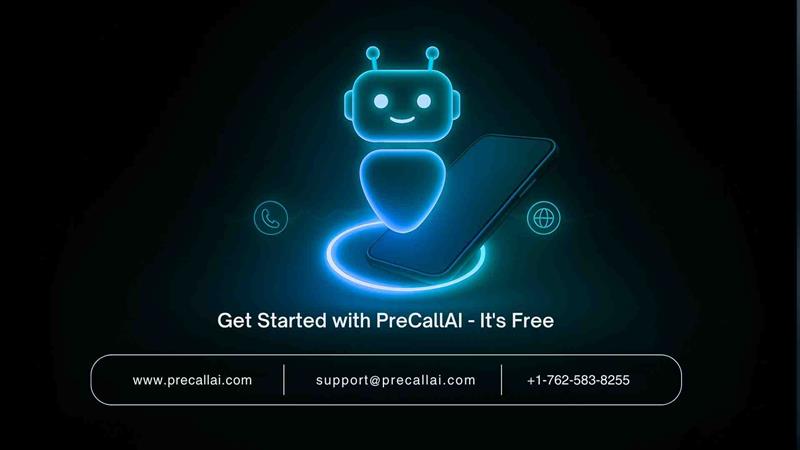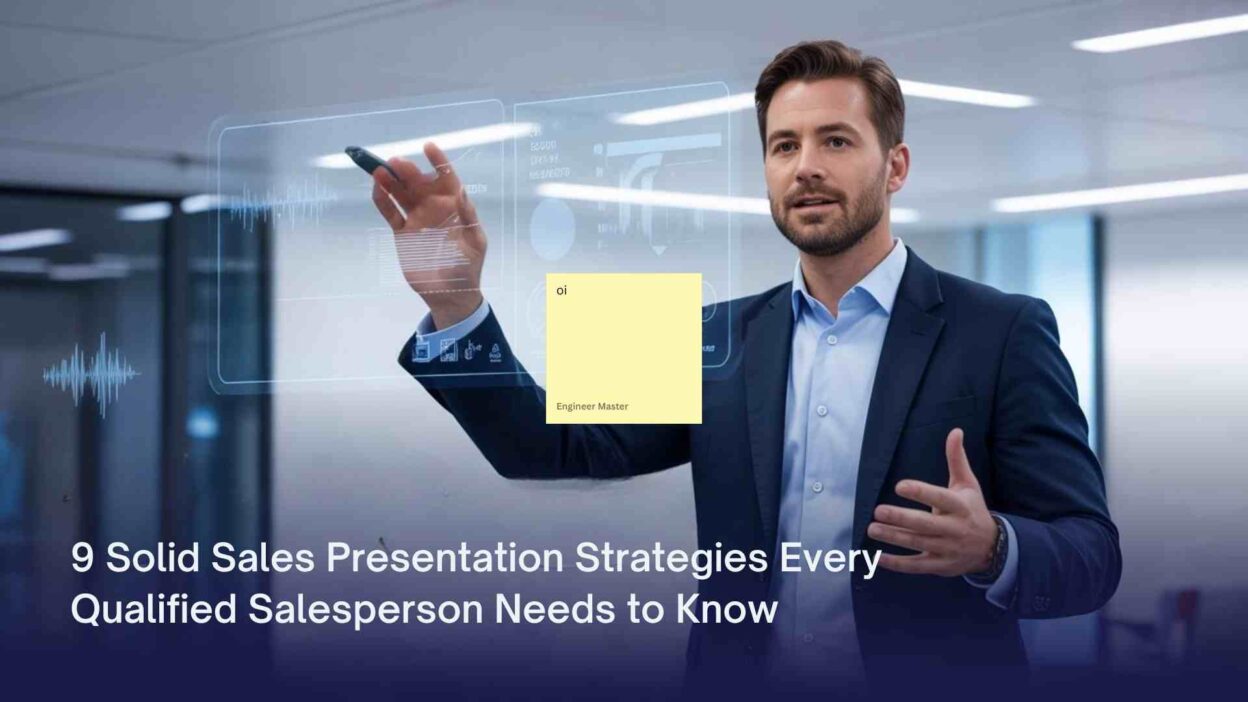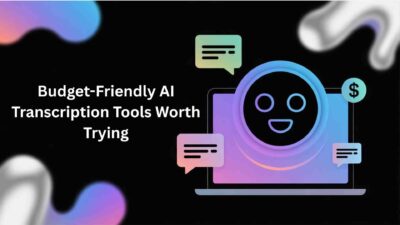Introduction
TL;DR Your product solves real problems. Your pricing beats competitors. Your service delivers exceptional value. None of this matters if your presentation fails. Sales meetings decide everything. You get one chance to impress. That chance demands perfection.
Table of Contents
Most salespeople struggle with presentations. Their decks contain fifty slides. Nobody stays engaged that long. The deal dies before it starts.
Effective B2B sales presentation tips transform average pitches into winning performances. Your close rates improve dramatically. Revenue follows naturally.
Qualified salespeople know presentation skills matter most. Product knowledge means nothing without delivery. Pricing flexibility helps nobody if you can’t communicate value. Your presentation carries the entire sales process. It deserves serious attention and constant improvement.
This guide reveals nine proven strategies. Each one comes from real-world success. Top performers use these techniques daily. Their quota attainment stays consistently high. Their commission checks reflect their skills. You can achieve the same results.
How to structure a winning sales deck puzzles many professionals. The right framework makes everything easier. Your message flows logically. Prospects follow your thinking. Questions arise at perfect moments. Objections get addressed before they surface. The structure itself sells for you.
These strategies work across industries. Software sales benefit immediately. Manufacturing presentations improve drastically. Professional services close faster. B2B companies see the biggest gains. Your specific market doesn’t matter. Human psychology remains constant. These principles apply universally and deliver consistent results every single time.
Strategy 1: Start With Their Problem, Not Your Solution
Understanding the Customer Pain Point
Your prospect faces real challenges. Those challenges cost them money. They lose revenue opportunities. Inefficiencies waste their resources. Competitors gain market share. Their team feels frustrated daily. These problems keep executives awake at night.
Most presentations skip this crucial step. Salespeople jump straight to features. They showcase product capabilities. They demonstrate fancy functionality. The prospect sits there confused. Nobody explained why they should care. The relevance never becomes clear.
Effective B2B sales presentation tips always prioritize pain points. You open with their reality, describe their current situation and quantify the impact accurately. Numbers make problems tangible. Real costs demand attention. Abstract concepts get ignored easily.
Research reveals specific challenges beforehand. LinkedIn shows company initiatives. News articles discuss strategic priorities. Earnings calls expose vulnerabilities. Their website announces new directions. Social media reveals frustrations. You gather intelligence systematically.
Validating Problems Through Questions
Discovery calls happen before presentations. You ask probing questions. You listen more than you talk. Prospects reveal their true struggles.
Never assume you know their problems. Industries differ dramatically. Company cultures vary widely. Leadership priorities shift constantly. What worked last quarter might not work now. Validation prevents embarrassing mistakes. You look like an expert who truly understands their business.
Present problems using their own words. Quote their VP of Operations. Reference their CEO’s interview. Mention their strategic plan. This approach builds instant credibility. They recognize themselves in your presentation. The connection feels personal and authentic.
Creating Urgency Around the Problem
Problems without urgency stay unsolved. Prospects accept the status quo. They delay decisions indefinitely. Your job involves creating urgency. The need for action becomes obvious.
How to structure a winning sales deck always includes urgency elements. You layer them throughout carefully. Early slides establish problems. Middle slides quantify growing impact. Later slides show the cost of inaction. The cumulative effect motivates decisions. Prospects want relief from pain. You position yourself as that relief. The problem-centric approach works because humans seek to avoid pain more than they seek pleasure. Fear of loss outweighs hope for gain consistently.
Strategy 2: Build Your Deck Around Three Core Messages
The Power of Three
Human memory works in patterns. Three items stick easily. Seven items overwhelm people. Ten items get forgotten immediately. Cognitive science proves this repeatedly. Your presentation should honor this reality.
Choose three key messages carefully. These messages form your backbone. Everything else supports them. Nothing distracts them.
Effective B2B sales presentation tips emphasize message discipline. The repetition feels natural, not annoying. Prospects internalize your messages subconsciously.
Structuring Content Around Messages
Your deck needs clear architecture. Slides cluster around each message. Transitions connect messages logically. The flow feels inevitable. Prospects follow your thinking easily. Confusion never enters the room.
Message one typically addresses their biggest pain. The credibility gets established here.
Message two focuses on your unique approach. Value proposition becomes crystal clear in this section.
Message three tackles implementation and results. The path forward looks achievable and attractive.
Reinforcing Messages Throughout
Every slide connects to a core message. Your talking points support them, stories illustrate them and data proves them. Nothing exists in isolation. Everything serves the strategy.
How to structure a winning sales deck depends on message clarity. Confused messages create confused prospects. Clear messages drive clear decisions. Your three themes should be memorable. Prospects should be able to repeat them after the meeting. They should be able to explain your value to colleagues. This happens only when you maintain ruthless focus on your core messages throughout the entire presentation.
Strategy 3: Use Data That Actually Matters to Decision-Makers
Identifying Relevant Metrics
Data impresses nobody by itself. Executives see numbers all day. They develop immunity to statistics. Your data must speak their language. It must address their specific concerns. It must connect to their priorities directly.
CFOs care about financial metrics. ROI demands their attention. Payback periods matter greatly. Total cost of ownership drives decisions. Cash flow impact cannot be ignored. Your data should reflect these concerns.
Operations leaders focus differently. Efficiency metrics grab them. Productivity improvements matter. Error rate reductions count. Throughput increases excite them. Time savings translate to cost savings. Tailor your numbers accordingly.
Presenting Data Visually
Numbers in paragraphs die invisible. Charts and graphs communicate instantly. Visual data processing happens faster. The brain handles images before text. Your slides should leverage this fact.
Simple charts beat complex ones. Bar graphs show comparisons clearly. Line charts demonstrate trends. Pie charts illustrate proportions. Tables work for detailed breakdowns. Choose formats that enhance understanding, not impress with complexity.
Effective B2B sales presentation tips include data visualization best practices. The insight should be obvious at a glance without requiring explanation.
Benchmarking Against Standards
Decision-makers love comparisons. How do they stack up? Where do they rank? What do peers achieve? Benchmarks provide context. They make your data meaningful.
Industry averages create urgency. Falling below average hurts pride. Executives want to lead, not follow. You show their current position. You show what’s possible. The gap creates motivation.
Competitor comparisons work carefully. The implication speaks louder than claims.
Proving Claims With Evidence
Every claim needs support. How to structure a winning sales deck requires evidence throughout. Case studies provide proof. Customer testimonials add credibility. Third-party research validates claims. Your own data demonstrates capability. The combination builds an unassailable case for your solution that prospects cannot easily dismiss or ignore.
Strategy 4: Tell Stories That Illustrate Success
Why Stories Trump Statistics
Numbers inform the brain. Stories move the heart. Both matter in sales. Logic justifies purchases. Emotion drives decisions. Your presentation needs both elements working in harmony.
Stories create emotional connections. Prospects see themselves in scenarios. They imagine similar success. They picture the transformation. The abstract becomes concrete. The possible becomes probable. Their objections start melting away naturally.
Effective B2B sales presentation tips always include storytelling. The narrative arc keeps people engaged and emotionally invested.
Choosing the Right Stories
Not every customer story works. You select cases that match closely. Similar industry works best. Comparable company size helps. Related challenges resonate. Prospects need to see themselves reflected.
Your stories should showcase different aspects. One demonstrates quick implementation. Another highlights ROI achievement. A third shows scalability. Each story proves a specific point. Each story addresses a different concern or objection.
Recent stories matter most. Last year beat five years ago. Current market conditions differ. Technology evolves rapidly. Prospects trust recent success more. Keep your stories fresh and regularly updated.
Structuring Stories Effectively
Every good story follows a pattern. This structure feels familiar and comfortable.
Start with relatable details. Mention the company name. Describe their situation. Use specific numbers. Quote their executives. Make it real and tangible. Generic stories lack impact completely.
Show the struggle honestly. Perfect journeys seem fake. Real implementations face obstacles. You overcame those challenges. This builds trust. Prospects know problems will arise. They want a partner who handles them effectively.
Bringing Stories to Life
How to structure a winning sales deck includes story placement. You sprinkle them throughout strategically. Each core message gets a supporting story. The stories provide proof points. They make abstract concepts concrete and memorable.
Use customer quotes liberally. Direct words carry weight. They sound authentic. They bypass skepticism. Video testimonials work even better. Seeing real people share experiences creates powerful credibility that no amount of data can match alone.
Strategy 5: Design Slides That Enhance, Not Distract
Less Text, More Impact
Crowded slides kill engagement. Paragraphs of text lose audiences. People read instead of listening. You lose control of the narrative. Your value diminishes immediately.
One idea per slide works best. Your talking points remain separate. Slides provide visual support only. You deliver the actual content. This division keeps attention focused on you where it belongs.
Effective B2B sales presentation tips emphasize visual clarity. Every element serves a purpose. Nothing decorative survives. The design stays clean and professional throughout.
Using Images Strategically
Relevant images boost retention. People remember visuals longer. Stock photos of handshakes waste space. Authentic images of your product work. Customer photos build credibility. Screenshots demonstrate functionality. Choose images that add value not just fill space.
Icons replace bullet points effectively. Your slides feel more modern and engaging with proper icon usage.
Maintaining Visual Consistency
Your brand colors appear throughout. Fonts stay consistent always. Layout patterns repeat predictably. This consistency looks professional. It builds subconscious trust. Chaotic design suggests chaotic solutions. Polished design implies polished products.
Templates help maintain consistency. You create them once. You use them repeatedly. Each presentation looks cohesive. Your brand becomes recognizable. Prospects remember you visually as well as conceptually.
Balancing Design and Content
Pretty slides don’t close deals. Content still matters most. Design enhances good content. It cannot fix bad content. You need both working together harmoniously.
How to structure a winning sales deck balances aesthetics and substance. Beautiful slides with no substance fail. Ugly slides with great content struggle. The sweet spot combines both. Your design supports your message. Your message drives decisions. The visual appeal keeps people engaged while your content persuades them to act and move forward.
Strategy 6: Handle Objections Before They Surface
Anticipating Common Concerns
Every product faces predictable objections. The price seems too high. Implementation looks complex. ROI timelines stretch long. Integration challenges loom. Your team knows these concerns intimately.
Smart presentations address objections proactively. You don’t wait for questions. You build answers into the deck. The concerns get resolved naturally. Prospects feel heard without speaking. Their confidence grows steadily throughout your presentation.
Effective B2B sales presentation tips include objection handling. The resistance melts before it hardens into firm objections.
Positioning Objections as Opportunities
Price objections need reframing. The value becomes obvious. Price seems reasonable suddenly.
Implementation concerns require honesty. Mountain becomes a manageable hill quickly.
Using Social Proof to Overcome Doubts
Other companies faced identical concerns. They moved forward anyway. They achieved great results. Their success proves your points. Prospects trust peer experiences more than vendor claims any day.
Share specific objection-busting stories. Company X worried about integration. You handled it smoothly. Company Y feared disruption. You minimized downtime. Company Z doubted ROI. They achieved payback in six months. Each story neutralizes a specific concern effectively.
Building Risk-Reversal Into the Offer
Guarantees reduce perceived risk. Money-back promises work. Pilot programs prove value. Phased implementations ease concerns. Free trials eliminate hesitation. Your terms should reflect confidence in your solution.
How to structure a winning sales deck includes risk-reversal elements. You present them naturally. You don’t oversell them. They exist as safety nets. Prospects feel protected. The decision becomes less scary and more logical.
Addressing the Elephant Directly
Sometimes you must name concerns. Your competitor costs less. Honesty builds trust. Avoiding obvious issues creates suspicion. Tackling them head-on demonstrates confidence. Your transparency becomes a selling point in itself. Prospects appreciate the directness. They respect the candor. The relationship strengthens because you treated them like intelligent adults who deserve straight answers.
Strategy 7: Create Interactive Moments Throughout
Breaking the Monologue Pattern
Nobody enjoys being lectured. Long monologues lose audiences. Attention spans last minutes, not hours. Your presentation needs engagement breaks built in systematically.
Ask questions throughout strategically. These moments re-engage wandering minds. People wake up when you ask them something directly.
Effective B2B sales presentation tips include interaction planning. The presentation becomes a conversation. Conversations build relationships. Relationships close deals more effectively than pitches ever will.
Using Polls and Quick Assessments
Live polls engage groups. You ask about their situation. You show results instantly. Everyone sees where they stand. The data informs your presentation. You adjust emphasis based on responses received.
Quick assessments work beautifully. You present a framework. You ask where they fit. They self-identify their stage. Your solution addresses that specific stage. The relevance becomes personal and immediate to everyone present.
Encouraging Questions Strategically
Some presenters fear questions. They lose control potentially. They might not know the answers. This fear hurts more than it helps you.
Welcome questions enthusiastically. You invite them at checkpoints. You don’t wait until the end. Questions reveal engagement. They show interest. They expose concerns early. You address issues before they grow into major blockers.
Demonstrating Instead of Explaining
Product demos beat descriptions. You show actual functionality. You let prospects experience it. They click around, explore features and imagine using it. The tangible experience sells better than words alone.
How to structure a winning sales deck incorporates interactive elements. Your solution becomes their solution mentally. This psychological shift drives decisions. People buy what they already feel belongs to them in some way.
Strategy 8: End With a Clear, Specific Next Step
The Call-to-Action Problem
Many presentations end weakly. Salespeople thank prospects. They offer to answer questions. They promise to follow up. Then nothing happens. The momentum dies completely. The opportunity disappears slowly.
Strong presentations end decisively. The path forward looks obvious and easy to follow.
Effective B2B sales presentation tips emphasize strong closes. Your clear direction actually comforts prospects who appreciate knowing what comes next.
Offering Multiple Paths Forward
Not everyone buys immediately. Different prospects need different next steps. You offer appropriate options for each situation type.
Ready buyers get a close.
Interested prospects need more information.
Skeptical prospects require proof.
Creating Urgency Around the Next Step
Limited-time offers work. Special pricing expires. Implementation slots fill up. You create legitimate urgency. The decision becomes more pressing and immediate.
How to structure a winning sales deck includes urgency elements.
Confirming Commitment Before Leaving
Everyone knows their responsibilities. The next step becomes real, not theoretical. You leave the room with concrete commitments. The deal advances measurably. Your forecast becomes more accurate. Your pipeline stays active and moving forward consistently at all times.
Strategy 9: Practice Delivery Until It Feels Natural
Why Practice Matters More Than Perfection
Polished decks mean nothing without delivery. Your slides provide structure only. You bring them to life. Your energy drives engagement. Your confidence builds trust. The delivery makes or breaks everything, regardless of content quality.
Natural delivery beats scripted reading. This requires extensive practice beforehand. Effective B2B sales presentation tips always include rehearsal advice.
Rehearsing Different Scenarios
Every presentation differs slightly. Questions interrupt your flow. Objections arise unexpectedly. Technical issues happen. You need flexibility built through practice sessions.
Run through best-case scenarios. Everything goes smoothly. Prospects love everything. You practice closing confidently. This builds positive associations mentally.
Rehearse worst-case situations. The demo fails catastrophically. Key stakeholders arrive late. Someone challenges every point. You practice staying composed. The real challenges feel manageable afterward.
Practice time variations. The one-hour meeting becomes thirty minutes. Your full deck won’t fit. You know which slides matter most. You hit key points efficiently. The flexibility comes from preparation, not improvisation.
Getting Feedback From Peers
Your colleagues see what you miss. They catch awkward phrases, notice confusing transitions and identify weak arguments. Their feedback improves your performance dramatically.
Run mock presentations regularly. You treat them seriously. You present like prospects are present. Peers interrupt with questions. They raise objections. You handle everything in real-time. The practice feels real because you make it real.
Refining Based on Real Presentations
Every presentation teaches lessons. You note what works, identify what flops and adjust accordingly. Your deck evolves continuously based on real feedback from actual prospects.
How to structure a winning sales deck includes version control. You track changes over time, test variations and measure results. The data guides improvements. Your presentation gets better with each iteration. Top performers never stop refining. They treat presentations as living documents, incorporate lessons learned and stay current with market changes. The commitment to excellence shows in results. Their close rates climb steadily. Their commission checks reflect their dedication to craft and continuous improvement.
Common Mistakes That Kill Sales Presentations
Talking More Than Listening
Salespeople love talking. Prospects need space to speak. They have questions, concerns and opinions. You need to hear them. The information shapes your approach. You adjust emphasis accordingly. Listening sells better than talking in almost every single situation.
Ignoring Body Language and Engagement Cues
People communicate nonverbally constantly. Crossed arms signal resistance. Leaning forward shows interest. Checking phones indicates boredom. Nodding demonstrates agreement. You must read these signals and respond appropriately.
Skipping the Discovery Phase
Some salespeople wing presentations. They use generic decks. They hope something resonates. This lazy approach fails consistently and predictably.
Discovery work happens first. This information customizes your presentation. The relevance increases dramatically. The close rate improves proportionally.
Overpromising to Close the Deal
Desperation shows through overpromises. Short-term gains become long-term disasters for your reputation.
Honesty builds lasting relationships. The trust pays dividends. Customers refer others. They renew contracts and expand relationships. The long-term value exceeds any single deal you might lose through honesty.
Failing to Follow Up Promptly
How to structure a winning sales deck means nothing without follow-up. You sent promised materials, answer outstanding questions, schedule the next meetings. and maintain momentum actively. Delays kill deals. Prospects lose interest. Competitors move in. Your presentation success gets wasted through poor follow-up execution and timing failures.
Frequently Asked Questions
How long should a B2B sales presentation be?
Thirty to forty-five minutes works for most situations. Shorter presentations rush important points. Longer presentations lose attention completely.
Request full-hour meetings. You won’t use it all. Buffer time helps tremendously. Questions extend presentations. Technical issues eat minutes. The extra time prevents rushing. You finish feeling relaxed, not stressed about the clock.
Effective B2B sales presentation tips suggest planning for interruptions. Prospects will ask questions. Stakeholders will arrive late. Phone calls will interrupt. Build flexibility into your timing. Your core content should fit thirty minutes. The rest handles unpredictable elements that always arise.
How many slides should a winning sales deck include?
Quality beats quantity always. Twenty to thirty slides cover most situations. You include introduction slides, and add problem slides. Each slide serves a specific purpose clearly.
One slide per minute seems reasonable. Forty-five-minute presentations support forty-five slides maximum. You won’t show them all. Some slides answer specific questions. Others address certain objections. You navigate dynamically based on the conversation flow and direction.
What makes a sales presentation memorable?
Stories stick in memory. Data gets forgotten quickly. Emotional connections last. Your personality matters greatly. Authenticity trumps polish. Prospects remember how you made them feel more than what you said exactly.
How to structure a winning sales deck focuses on memorability. The mental shift stays with them. They remember you when decision time arrives inevitably.
Should I customize every sales presentation?
Absolutely customize for important opportunities. Large deals deserve tailored approaches. Strategic accounts need personalized attention. The customization shows respect and professionalism.
Template decks work for smaller opportunities. You can’t customize everything. Time constraints exist. Standardized presentations maintain quality. You swap certain slides. You adjust talking points. The framework stays consistent. The content flexes appropriately.
How do I handle technical questions I cannot answer?
Honesty always works best. This builds more trust than fumbling through bad answers or making things up.
Bring technical experts when possible. Sales engineers handle deep questions. Product managers explain roadmaps. Implementation specialists discuss timelines. The team approach shows depth. It also prevents knowledge gaps from derailing your entire presentation and momentum.
Launch your AI assistant now and scale effortlessly
Conclusion

Your sales presentation carries enormous weight. Product quality matters less than you think. Pricing flexibility helps, but doesn’t guarantee wins. Your ability to present effectively determines success. Everything depends on those crucial thirty to forty-five minutes in front of prospects.
These nine strategies work in combination. You cannot cherry-pick one or two. Each strategy supports the others. Each strategy fills specific gaps. The complete system transforms your presentations.
How to structure a winning sales deck becomes second nature eventually. The structure serves you instead of constraining you. Your presentations feel fresh yet follow proven patterns that work consistently.
Sales leadership notices great presenters. Promotions follow naturally. Larger accounts get assigned. Speaking opportunities arise. Your career trajectory changes. These skills serve you for decades. They transfer across industries. They survive technology changes. Presentation excellence remains valuable forever in any market or economy.






[…] Read More: 9 Solid Sales Presentation Strategies Every Qualified Salesperson Needs to Know […]